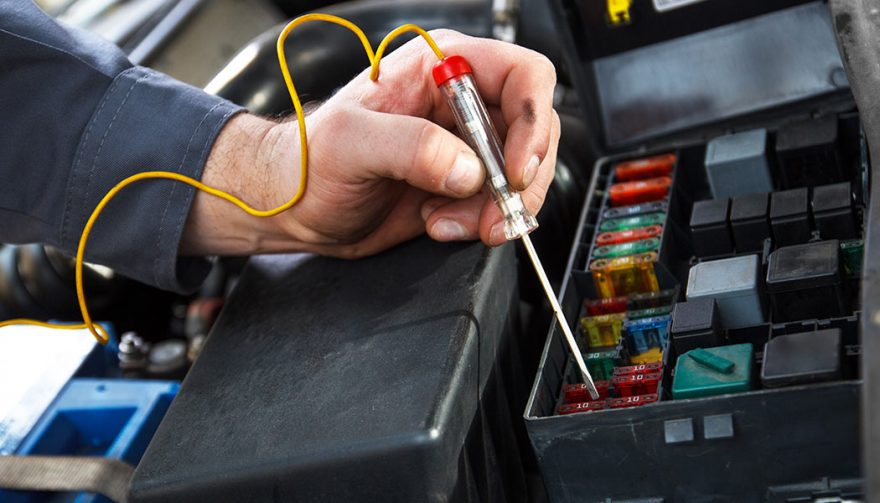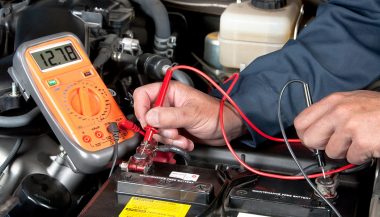
Faulty circuits can be the most befuddling of car electrical repairs.
Car Electrical Repairs Part 2: Faulty Circuits
Auto parts stores on Saturday mornings can look like they are hosting 12-Step meetings. Men are discussing car electrical problems that they can’t solve, asking for help and insight. They seek advice from the parts people, and receive counsel from other customers as well. Since men are so notoriously averse to asking for directions, why are we so willing to ask for mechanical help?
For two reasons. The first is anonymity. As the code says, what happens at the parts store, stays at the parts store. Second, mistakes are expensive. The most befuddling car problems are electrical in nature. Many good electrical parts are replaced because of misdiagnosis, misunderstanding and just plain guessing in error. That can be very expensive, too, because often car electrical and electronic parts can’t be returned for a refund after they’ve been installed.
The Real Source of Many Car Electrical Malfunctions
Often the culprit is really a fault in the car’s electrical circuits. Either there is a fault in the circuit that feeds power to the part that isn’t operating correctly, or in the circuitry that provides the part’s ground path. Therefore, some basic knowledge and diagnostic skills can save us a lot of frustration and expense.
Let’s say a car is overheating because its electric cooling fan, mounted behind the radiator, doesn’t come on. That’s a very common malfunction. So our anonymous friend takes his new test light (as described in Part 1 of this series) and finds the fan motor has power at its positive (input) terminal. Good. Next he tests the motor’s negative (its ground) terminal, and finds full power again. But the motor isn’t running. So our friend next uses his new DVOM (again, from Part 1) and finds battery voltage, over 12 volts, at both fan terminals. That’s weird, we might assume. The fan motor has power but doesn’t run, so it gets replaced. But the new fan motor doesn’t run either. That’s when the struggle and expense begin. Seeking help, our friend joins the next Saturday morning meeting at the auto parts store.
Electricity Is Impatient
Electricity flows through a circuit like traffic flows during rush hour. Already we see why car electrical repairs are frustrating. Even the term ‘rush hour’ doesn’t make sense, because we don’t say slowly moving traffic is rushing, certainly not like we would say a river current is rushing. But when there is a restriction to traffic flow, like an accident or breakdown (probably because somebody’s cooling fan quit), drivers seek alternative paths home; a detour. Same with electricity. It seeks an easier path to follow, and looks for its own detour. Still with me?
A tiny bit of resistance in car electrical circuits is normal, but excess resistance causes all kinds of problems, especially with electronic components that draw very little power to begin with. How would we measure resistance? With our DVOM. The ‘O’ stands for ohms, the units of resistance we can measure. The little instruction booklet that came with our anonymous friend’s DVOM would say to remove all power from a circuit (pull its fuse), and attach the two leads to either end of the circuit. The meter will create a small, pulsing charge at one lead, and then measure how much of it actually makes it to the other end of the circuit. (Obviously, don’t do this with your air bag circuits, or seat belts that have pyrotechnic actuators.)
This test would be awkward with our fan motor circuit, but it could be done to illustrate the testing principle. Say you wanted to test the portion of the circuit that runs from the fuse, through the wiring harness, and on to the motor’s positive terminal. Straightforward, but unwieldy. Also, suppose the wire you are testing contains 12 strands, but 8 of them are broken. The remaining four would be enough to transmit the tiny DVOM’s pulsing test current, and give us an OK reading. But the four good strands are not enough of a path to satisfy the fan motor’s voracious appetite for current. But the testing principle is the same.
Actually, if our friend had consulted his repair manual, it would have instructed him how to use his new DVOM to test for excess resistance within the fan motor. It would have first showed him how to test between the motor’s positive and negative terminals. Then it would also have led him through a simple procedure to test for shorts, from power to ground, within the motor’s windings. Armed with that knowledge, he would have known that the fan motor was good, and not have replaced it.
You Can Test Many Electrical Parts Yourself
Fuel injectors, ignition coils, fuel pumps, window motors, windshield wiper motors, and many other car electrical components can easily be tested with the ohm feature on your DVOM. You will find their specifications for ranges of resistance in your repair manual. Knowing how to test electrical items is a good skill to develop. But we still haven’t fixed our friend’s cooling fan.
Measure for the Detour Instead – It’s Easy
The fan motor requires a heavy current, more than four tiny strands of wire can deliver. It’s similar to the way a fire hydrant supplies a heavier current (flow) of water, compared to a small garden hose spigot. Same principle with electrical currents.
The 8 broken wires resist flow, completely, 100%. They are completely open at the break. Since the current is restricted, like rush hour traffic near an accident, it seeks a detour. The test for that detour is called a ‘voltage drop test,’ which we perform on live circuits.
Suppose we want to test the entire power supply circuit to the cooling fan; all the way from the battery’s positive terminal, through all the wire segments, switches, connectors and relays, to the fan’s positive (input) terminal. Easy!
The Voltage Drop Test is Your Friend
With the fan under normal operating conditions, connect the test light’s alligator clamp to the battery’s positive terminal. Now touch the point of the test light to the fan motor’s positive terminal. In a solid, good circuit with no resistance the light won’t come on. But, since we have 8 broken strands, the current immediately seeks a detour to reach the fan’s input terminal, and finds it by traveling through the test light. The light comes on, and really bright, too. Congratulations. You’ve determined the circuit has a fault, and can’t feed the fan motor.
But exactly which part of the circuit has the fault? Simple, again. Touch the test light tip to the next connection on the circuit, towards the battery side. Say it’s a relay output. Light still on? Then go to the relay input. Keep moving backwards along the circuit till you come to the place where the light no longer illuminates. The fault is between that point and the location you last tested. See how the voltage drop test works, fast and easy? No? That’s ok. These concepts take a little ‘hands on’ experience before they sink in. Learning is part of the fun of fixing cars. But you can look forward to impressing your friends with your new knowledge.
Suppose the power side of the fan circuit was good. In that case we would have then tested the motor’s ground path. It’s simple. Move the alligator clip to the battery’s negative terminal. Now touch the test light tip to the fan’s negative terminal. If the light comes on, it means that the ground circuit has excess resistance, possibly an open, which is forcing the current to detour through the light, illuminating it. Note that the tiny filament inside the test light’s bulb can’t carry enough current to actually make the fan motor run. The illuminated light, however, does show us that the motor’s ground path is open somewhere, or has very high resistance at some point (like a loose connection). Move the tip of the test light along the ground path, isolating each segment, till you find the component or connection that is open.
Since small car electrical motors are typically switched on by relays in their ground circuit, let’s say that our friend determines that he has a bad relay. He could easily verify his diagnosis, which is always a great idea, by substituting in a known good relay. Perhaps he could borrow one from the windshield wiper circuit, and verify that the cooling fan does now operate normally. Then return the wiper relay to its home, and go buy a new fan relay. Locating the real culprit is more satisfying than replacing a fan motor that’s not bad.
One Headlight Is Dim and the Other One Is Bright
The ohms test is most often used to test car electrical components, which is called ‘bench testing.’ The voltage drop test, though, is most often used on live circuits, under their normal operating load. Like headlights that don’t burn evenly bright.
Connect your test light’s alligator clip to the battery’s negative terminal, and touch the point to each headlight’s positive (power) terminal. Both terminals will illuminate the lights, so you have power there.
Now touch each light’s negative terminal. The one that burns dim will probably illuminate the light really bright. That means there is excess resistance in that light’s ground circuit. Remember? The ground is detouring through the test light.
To really be fancy, you could set your DVOM to DC volts, touch the negative probe to battery negative, and the positive probe to the dim headlight’s ground terminal. Your DVOM will give you a reading of something less than 12 volts. Whatever the reading is, that is your exact amount of excess resistance. That’s why it’s called a ‘voltage drop.’ Make a little more sense now?
Unlike electric motor circuits, lights usually are switched on from their power side. Lighting ground circuits, then, normally run directly from the light to a nearby chassis or body ground. You’ve probably seen many chassis grounds scattered throughout your car. Find them under the dashboard, inside the trunk, and in the engine compartment. They will be little metal eye terminals on the ends of one, two or possibly several wires bundled together, with a hex-head screw running through the eyelet and into the metal ground.
The screws work loose over time. With our dim headlight, since its ground is exposed to weather, moisture caused corrosion to form between the eyelet and the chassis. That’s very common with exterior lights. Simply remove the screw, clean both sides of the eyelet and the metal ground with sandpaper, and then attach it soundly. The headlight should now burn brightly.
Closing Tips
With an electric motor that doesn’t run (like our fan motor), but has good power and ground, try this. Hit it sharply with a wrench. Motors develop bad spots, and if they happen to stop turning at a bad spot they won’t come on. A sharp hit will often jar them into action, and spare you all that testing of circuits.
Problems with poor car electrical grounds are more common than problems with power supply circuits. Grounds come loose, corrosion forms, and then they make intermittent contact. For erratic electrical problems always suspect a poor ground.
Relays are normally used in the ground paths of car electrical components. A signal closes the relay, which completes the ground path, actuating the component.
An electrical part, like a windshield wiper motor, that keeps melting its fuse is not necessarily bad. Disconnect the motor, then replace the fuse. If the fuse blows again, that circuit is shorted to ground, or another component on that fuse circuit is bad. Unplug the components on that fuse circuit one by one, till you find the bad one.
Excess resistance causes heat. For example, if you see wire connectors that show signs of melting or burning, their connections were loose or corroded.
That’s it. Now you have enough car electrical knowledge to perform a few more electrical tests when something on your car isn’t working right. Maybe your neighbor will come over, and ask you to help him fix something. Now you can show off what you know.





